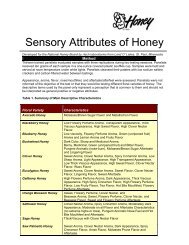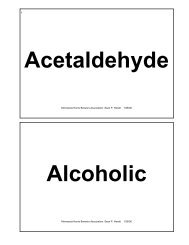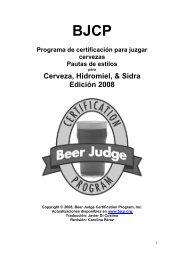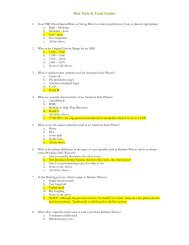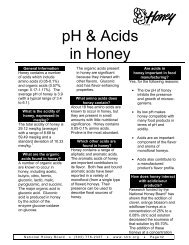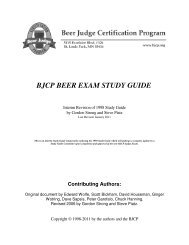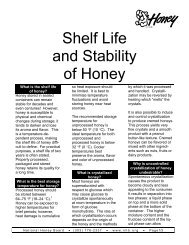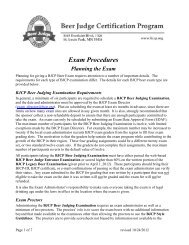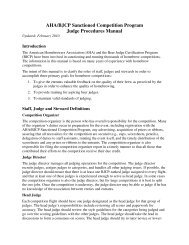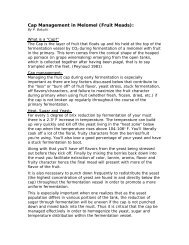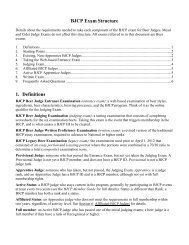Making Mead - BJCP
Making Mead - BJCP
Making Mead - BJCP
Create successful ePaper yourself
Turn your PDF publications into a flip-book with our unique Google optimized e-Paper software.
For example, water thathas a high chlorine contentmay produce off-flavors.Most mead makers recommendbottled or springwater but not distilled watersince it lacks sufficientminerals for the yeast.OTHER INGREDIENTSACIDS: Small amounts ofacids, such as malic,tartaric and citric acid, areadded to balance theflavor. Their tartnessoffsets the sweetness ofthe honey while combiningwith the alcohol to give adegree of stability againstspoilage.Some experts recommendan acid blend composed oftwenty-five percent citric,thirty percent malic andforty-five percent tartaricacids.SULFITES: Sodiumbisulfite or potassiummetabisulfite in tablet orpowder form are commonlyused for sanitation in winemaking.STABALIZERS: Whenmaking still mead,potassium sorbate, or winestabilizer, can be added atthe bottling stage toprevent a secondfermentation by killingremaining yeast cells.FRUIT: To create thefruit-containing mead, tento twenty percent fruit juiceor purees are added to thehoney-water mixture.Whole, pitted fruit can alsobe used. Twelve to fifteenpounds of fruit with twelveto fifteen pound of honey infive gallons arerecommended.SPICES AND HERBS:Almost any spice or herbcan be added to meadeither as an extract ordirectly at almost any timeduring the mead makingprocess. Blends of two ormore spices and herbs arecommonly used. If addeddirectly, they should notremain in the mix for longerthan twenty-four hoursbecause bitter componentsmay be extracted.A strong extract of mixedherbs (gruit), can be addedat bottling time. Or, astrong extract of eachspice can be prepared andadded at any time afterfermentation but before fining.To make an extract,boil the spices in a smallamount of water for 15minutes.HOPS: Adding hops tomead will add a distinctiveflavor, but moreimportantly, its resins, oils,tannins and pectin can helpto clarify the mead andpreserve its freshness.Tannin is sometimes usedby itself to add astringencyand aid in brewing andclarification.Getting Started:EquipmentHome brewers typicallymake five-gallon batches ofmead. The equipment theyneed is similar to what isused to make wine and isreadily available in homewine and brewing supplystores.Basic equipment needed toproduce five-gallon batchincludes:•= 1 (four-gallon)enameled or stainlesssteel pot•= 2 (five-gallon) glasscarboys*•= 1 fermentation lock withrubber cork to fit carboy•= 7 feet clear plastic siphoninghose, 5/16-inchdiameter•= 3 feet plastic blow-outhose, 5/16-inchdiameter•= Detergent and chlorinebleach•= Large funnel•= Corker or bottle capper•= Corks or bottle caps•= Bottles•= Wine hydrometer•= Thermometer•= Acid-testing kit*Note: A carboy is a glasscontainer with a narrow neck.National Honey Board • (303) 776-2337 • www.nhb.org • P a g e 4/12



